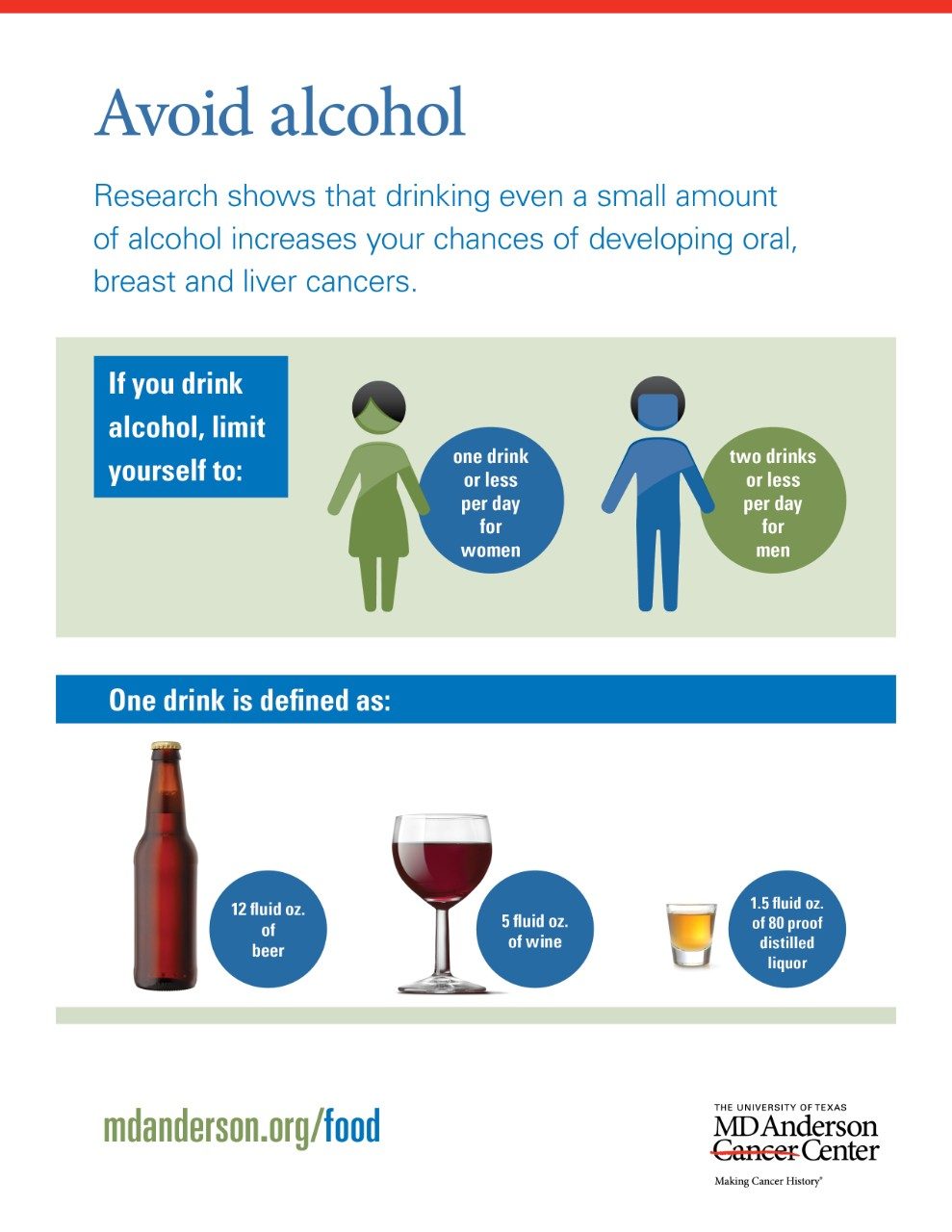Guide: Alcohol and cancer
Research shows that drinking even a small amount of alcohol increases your chances of developing cancer, including oral, breast and liver cancer.

Some research shows that drinking even a small amount of alcohol increases your chances of developing cancer, including oral, breast and liver cancer.
But there also is research suggesting that small amounts of alcohol may protect the body against heart disease and type 2 diabetes. Some evidence even suggests that red wine may help prevent cancer.
Confused? Use our beverage guide to choose a drink with the lowest health risk. You’ll learn your recommended drink limit and what alcoholic drinks to avoid.
Stick to the recommended serving size
The research is clear on this point – heavy drinking damages cells and can lead to cancer. So, if you must drink, do so in moderation.
Alcoholic drinks come in three forms: beer, wine and liquor. A drink serving is defined as 12 ounces of beer, five ounces of wine or 1.5 ounces of liquor.
The National Cancer Institute recommends that women have no more than one drink per day and men have no more than two drinks per day.
Recommendations for women are lower than for men because they have less total body water to dilute the effects of alcohol. This means alcohol stays in a woman’s body longer than in a man’s. And, the longer large amounts of alcohol stay in the body, the higher the risk for brain and organ damage, high blood pressure, stroke and other injury.
Select low-calorie options
Many of us get way too many calories from what we drink, not just in alcoholic beverages — about 460 calories a day. That can lead to a growing waistline, which also can increase your cancer risk.
Before taking a sip of alcohol, check the bottle label and look at the calories per serving, if listed. Many popular drinks are loaded with empty calories, especially drinks mixed with soda, fruit juice or cream. Eggnog is one of the biggest holiday offenders with about 340 calories per one-cup serving.
The chart below from the US Department of Health and Human Services lists the calories found in many popular drinks.
| Beverage | Recommended Serving Size | Approximate Total Calories |
| Beer (regular) | 12 oz | 144 |
| Beer (light) | 12 oz | 108 |
| White wine | 5 oz | 100 |
| Red wine | 5 oz | 105 |
| Sweet dessert wine | 5 oz | 141 |
| 80 proof distilled liquor (gin, rum, vodka, whiskey) | 1.5 oz | 96 |
| Champagne | 3 oz | 75 |
Want a mixed drink—a martini or margarita—perhaps? Be sure to choose the option with the fewest calories per serving. Or, create a low-calorie blend by adding diet soda or water.
Stay away from 100-proof liquor
It’s the ethanol or alcohol in beer, wine and liquor that researchers believe increases cancer risk.
So while you’re checking the bottle label, check the ethanol percentage or number as well. You’ll find either an alcohol by volume (ABV) percentage or an alcohol proof number.
ABV and alcohol proof are standard measures used worldwide to show how much alcohol or ethanol is in a beverage. In the United States, the alcohol proof number is twice the ABV percentage.
Beer, wine and liquor contain about the same amount of alcohol per serving — about half an ounce. That equals to about:
- 40% ABV or 80-proof in liquor
- 2 – 12% ABV in beer
- 9 – 18% ABV in wine
Avoid anything with even more alcohol than what’s listed above, like 100-proof liquor. This also is important because how much you drink over time still matters more than what you actually drink.
Non-alcoholic drinks remain the healthiest option
Celebrations may come with fully stocked bars and encouragement to join in. But avoiding alcohol, or limiting the amount you drink, is your best bet for staying healthy.
If you’re looking for a non-alcoholic drink with a cocktail-like feel, try club soda and lime. It has minimal calories and health risks. Remember, alcoholic drinks offer few nutritional benefits. So, look for healthier food sources to get your holiday calories.





